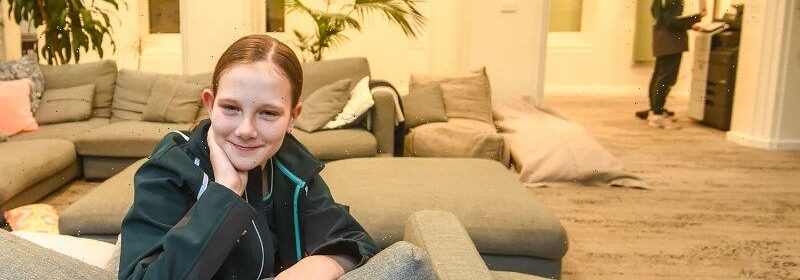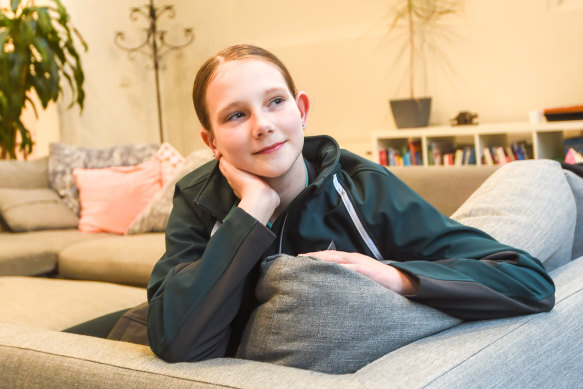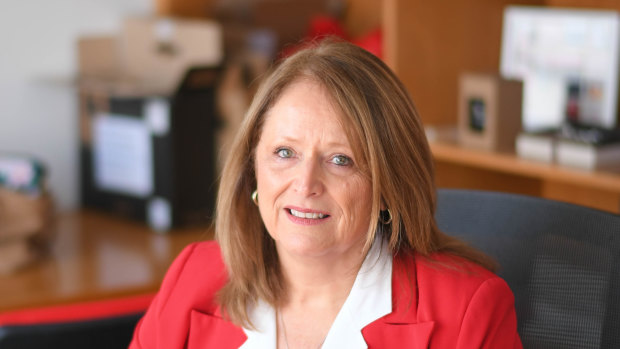Country students fill boarding school beds left by internationals

Key points
- Victorian boarding schools have been hard hit by lockdowns and international and state border closures during the pandemic.
- Their enrolments are down more than 12 per cent on pre-COVID levels, compared with a 0.6 per cent decline across Australia.
- Rural students have emerged as a bright spot, with enrolments up 46 per cent across Victoria.
- The Australian Boarding School Association does not expect large numbers of international boarders to return until at least 2024.
Boarding schools in Victoria are increasingly turning to country students to fill the hole left by an exodus of international enrolments.
Two of the state’s boarding houses have closed in the past two years, and new data shows enrolments for live-in places at Victorian schools have fallen 12 per cent since 2019.
Young boarder Mabel Golland, who joined MLC this year from Wagga Wagga, NSW. Credit:Justin McManus
The trend is being attributed to border closures and lockdowns during the COVID-19 pandemic, but is not as prevalent elsewhere in the country, with the national figures showing boarder numbers are down just 0.6 per cent.
Lucrative international enrolments at Victorian boarding schools have slumped more than 50 per cent on pre-pandemic levels, and are unlikely to bounce back until at least 2024, the Australian Boarding School Association said.
But president Richard Stokes said rural students have emerged as a growth market for Victorian boarding schools, and now account for 61 per cent of boarders, up from 37 per cent.
“People realised that boarding schools looked after kids really well,” Stokes said. “And some people felt isolated in rural areas during COVID.”
Among the new boarders from regional Australia is Mabel Golland, a 12-year-old from Wagga Wagga in NSW. She joined Kew girls’ school MLC this year and her younger sister will follow suit in 2023.
Living away from home has been exciting for Mabel, and she has adjusted to the sound of trams. Her typical weekday includes school, meals, free time and homework, while on weekends boarders do activities such as cooking.
The figures come as Kilmore boarding school Colmont School prepares to shut its doors to its remaining students after entering administration in late July, leaving hundreds of families searching for a new school.
In-demand Mount Waverley independent school Huntingtower stopped boarding in late 2020 to focus solely on its day students.
Principal Andrew Houghton said boarding wasn’t a huge need locally, and the school didn’t need to enrol international students.
“I know it can be perceived as helpful to promote cultural diversity and also financially advantageous by other schools, but we’re here to support our local community,” he said.
The school’s boarding house was turned into a student wellbeing centre, providing counselling, a therapy dog and a student-run coffee cart. Three remaining international students shifted to homestays.
International students were forced to choose between staying indefinitely in Australia or returning home to study remotely when Australia closed its border in early 2020. Fully vacccinated international students started to return late last year, although enrolments remain well below pre-COVID levels.
Tracey O’Halloran says many factors will influence how quickly international students return to Victorian schools. Credit:Eddie Jim
While numbers have fallen, the “education state” still has more international boarders than anywhere in Australia. International students are charged much higher fees than locals.
The biggest of Victoria’s 29 boarding schools is Geelong Grammar – which charges international students $84,580 for tuition and boarding in year 12 – followed by boys’ schools Scotch College and Melbourne Grammar.
Tracey O’Halloran, who helps Australian schools market themselves to prospective students overseas, said while domestic students had filled the breach left by internationals, the uncertain economic outlook raised questions about whether the trend would continue.
Stokes said schools attended expos and asked alumni to host functions to attract new country students. She said enrolments of Indigenous students had decreased because Victoria’s lockdowns and state border closures prompted many interstate students to return home.
Paul O’Shannassy, who helps families choose a school for their child, said an increasing number of families from urban areas were looking at boarding options for their kids.
“An interesting development is city kids seeking out rural boarding schools for a fresh start after lockdowns,” he said. “Many young people have emerged with mental health issues, school refusal and many other challenges, and several parents say a change of environment is necessary.”
The Morning Edition newsletter is our guide to the day’s most important and interesting stories, analysis and insights. Sign up here.
Most Viewed in National
From our partners
Source: Read Full Article

